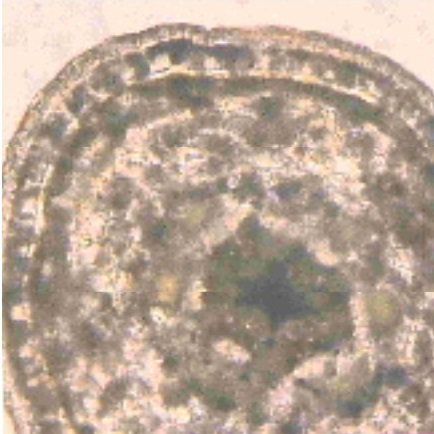
Calligonum comosum / الارطا
C. polygomoides subsp. comosum (L`Her.) Soskov
Arti , Arta`,waragat alshams , Ramo, Tape
Arta`, A`bal , waragat Alshams
Polygonaceae

Flowers

Fruit

Herbarium Sample
Ethnobotanical Characteristics
Description
Woody based ascending shrub, glabrous much branched, erect up to 250 cm high, older branches rigid with whitish gray bark and swollen knotty nodes, young shoots green flexible 1-2 mm in diameter, branching and angled at nodes. Leaves minute, soon deciduous and usually absent. Flowers 0.5 cm across, on pedicels about equaling or somewhat exceeding the perianth lobe from leaf nodes, sometimes clustered; perianth lobes oblong, obtuse c. 2.8-3 mm long, white pink or white- greenish with darker medial part; anthers many, bright –red in color. Fruit capsule, red or greenish yellow with 4 pairs of longitudinal wings, covered with short-branched stiff red bristles, 1-2 cm long, becoming dirty yellow when mature.
Habitat & Distribution
It is a plant of tropical and subtropical regions. Widespread in UAE. Frequent to common in deeper sand, dunes, plains and valleys; cultivated around desert plantations as windbreaks; tolerates saline conditions.
Part Used
Aerial Parts, fruits and young twigs
Traditional & Medicinal Uses
The plant is astringent, stimulant, tonic; in U.A.E the plant is used for ophthalmic and stomach problems and for hair scenting and dying. The dried leaves & stems used to treat toothache; young twigs edible added to milk or rice; the plant is used as firewood which gives smokeless fires and for tanning; fruits edible; the plant is a good fodder for livestock. The flowers give a rich protein powder.
Pharmacognosy and Phytochemistry
Parts studied
Branches
Microscopical Description
A transverse section of a branch shows almost a circular outline. The epidermal cells are small and oval covered with a thick striated yellowish cuticle. The outer part of the cortex composes of two layers. The outer one consists of rounded or oval cells most of which are filled with single cluster crystals of calcium oxalate while the inner one consists of longitudinal periclinal cells many of which are filled with larger single cluster crystals of calcium oxalate. The inner part of the cortex consists of a large zone of polygonal or rounded cells with thick cell walls part of which contain large cluster crystals of calcium oxalate. The vascular tissues are embedded in the inner part of the cortex forming six zones separated by few parenchyma cells. Both phloem and xylem tissues are rich in fibres. The vessels are mainly spirally thickened. The pith occupies a small central position and it is composed of dark coloured parenchyma cells.

a) TS of branch

b) TS of a branch

c) Detailed TS of branch
- (a) TS of a branch showing a general view of the different zones.
- (b) TS of a branch showing dark spots as cells filled with calcium oxalate cluster crystals and the yellowish areas at the central part as the phloem tissues.
- (c) Detailed TS of a branch showing the outer epidermal layer underlain by two layers of the outer cortex some with cells containing calcium oxalate crystals followed by a large zone of the inner part of the cortex. (Magnifications: x 100, x100 and x 400, respectively).
Organoleptic characteristics
Appearance: Solid powder
Colour: Pink
Odour: Odourless
Taste: Tasteless
Physicochemical constants
Loss in weight on drying at 105 °C (%): 8.80
Solubilities (%)
Alcohol solubility: 15.60-16.00
Water solubility: 18.40
10% ethanolic extractive: 37.39
Ash values (%)
Total ash: 8.60
Water soluble ash: 2.40-2.60
Acid-insoluble ash: Nil
Successive extractive (%)
Petroleum ether (60-80 °C): 0.50-0.60
Chloroform: 0.50
Absolute alcohol: 17.10
Distilled water: 15.30
pH values
pH of 1% solution: 5.04
pH of 10% solution: 4.66
Chemical constituents
Anthraquinones and flanovonids. (DPS, ZCHRTM unpublished results; Kamil et.al 2000; Ghazanfar 1994).
Pharmacological and Toxicological studies
The 10% ethanolic extract of the aerial parts of Calligonum comosum (50-400 mg/kg, i.p.) significantly reduced the increase in hind paw oedema induced by carrageenan in rats. Pre-treatment with the extract (100, 200 and 400 mg/kg) produced a significant and dose-dependent inhibition to the acute gastric ulcers induced by phenylbutazone, indomethacin, 0.2 N NaOH and 80% ethanol (Liu et. al., 2002). The pharmacological and toxicological studies carried out in our laboratory and the results in brief, on Calligonum comosum (10% ethanolic extract) have been given below. The results presented without references showed unpublished data (ZCHRTM, DBMS)
|
ACTIVITY |
RESULTS |
|
Anti-inflammatory activity-Rat paw oedema activity. |
Extract did not show anti-inflammatory |
|
Anti-inflammatory activity-Cotton pellet activity. |
Extract did not show anti-inflammatory |
|
Anti-inflammatory activity-Topical application activity. |
Extract did not show anti-inflammatory |
|
Antinociceptive activity-Tail flick, orally administered |
Extract showed antinociceptive activity. |
|
Antinociceptive activity-Tail flick, i.p. |
Extract showed antinociceptive activity. |
|
Studies on gastric ulcers- Indomethacin |
Showed protective effect. |
|
Studies on gastric ulcers-Phenylbutazone induced |
Showed protective effect (Islam et. al.,1999; Liu et. al., 2002). |
|
Studies on gastric ulcers-NaOH induced |
Showed protective effect (Islam et. al.,1999; Liu et. al., 2002). |
|
Studies on gastric ulcer-Ethanol induced |
Showed protective effect (Islam et. al.,1999; Liu et. al., 2002). |
|
Studies on gastric ulcer -Cold stress |
Showed protective effect (Islam et. al., 1999; Liu et. al., 2001). |
|
Antisecreatary activity- Gastric acidity |
Showed protective effect (Islam et. al.,1999; Liu et. al., 2001). |
|
Anti-hypertension activity-Anesthetic rats |
Changed blood pressure & Heart rate (Radha et al., 1999). |
|
Vasorelaxant activity-Isolated aortic strip |
Increased the force of contraction (Radha et al., 1999). |
|
Cardiotonic activity & HR-Isolated rat atria |
Increased the force of contraction (Radha et al., 1999). |
|
Skeletal muscle relaxing activity-Grip strength method |
Failed to show relaxant activity. |
|
Gross behavioral studies-Tremor/Twitches |
No toxic symptoms observed. |
|
Gross behavioral studies-Writhing |
No toxic symptoms observed. |
|
Gross behavioral studies- Diarrhea, Urination |
No diarrhea and urination recorded. |
|
Mortality |
No mortality recorded. |
|
Anti-asthmatic activity-Tracheal chain |
Produced mild relaxation. |
|
Acute toxicity studies |
No toxic symptoms observed. |
|
LD50 evaluation (Oral) |
>6400 mg/kg. |
|
LD50 evaluation (i.p.) |
>800 mg/kg. |
Summary of the results
The Calligonum comosum (10% ethanolic) extract showed antigastric activity and antihypertension effect. The LD50 .> 6.4 g kg, p.o. The plant extracts in lower doses could be utilized for the antigastric ulcer activity.
References
- Department of Biomedical Sciences, Zayed Complex for Herbal Research and Traditional Medicine, Unpublished results.
- Department of Pharmacognostic Sciences, Zayed Complex for Herbal Research and Traditional Medicine ( ZCHRTM ), unpublished results.
- El-Ghonemy, A. A. Encyclopedia of Medicinal Plants of the United Arab Emirates. (1993) 1st Edition, University of UAE.
- Ghazanfar S A. Handbook of Arabian Medicinal Plants, CRC Press, p.173, 1994.
- Islam, M.W., M.N.M. Zakaria, R. Radhakrishnan, X.M. Liu, H.B. Chen, K. Chan and M. Habibullah. Effect of ethanolic extract of Calligonum comosum (Fam. Polygonaceae) on experimental induced gastric ulcers in Wistar albino rats. J Pharm Pharmacol. 1999, 51 (Suppl): 102.
- Jongbloed, M.V. The Comprehensive Guide to the Wild Flowers of the united Arab Emirates, Erwda, (2003) Emirates Printing Press, Dubai, U.A.E.
- Kamil M, Jayaraj A.F; Ahmad F, Gunasekhar C, Samuel S, Habiballah M, Chan K. Pharmacognostic & Phytochemical Standardization of Calligonum comosum. J. of Pharmacy & Pharmacology, 2000 52 (supp.): 262.
- Kotb, T. F. Medicinal Plants in Libya.(1985) Arab Encyclopedia House. Tripoli-Libya.
- Liu XM, Zakaria MN, Islam MW, Radhakrishnan R, Ismail A, Chen HB, Chan K, Al-Attas (2002) A. Anti-inflammatory and anti-ulcer activity of Calligonum comosum in rats. Fitoterapia. 72(5): 487-91.
- Mandaville,J.P. Flora of Eastern Saudi Arabia. (1990) Kegan Paul International Ltd. England.
- Miller A.G., Morris M. Plants of Dhofar, The southern Region of Oman: Traditional, Economic and Medicinal Uses.(1987) Office of the Advisor for conservation of the Environment, Sultanate of Oman.
- R. Radhakrishnan M.N.M. Zakaria, M.W. Islam, H.B. Chen, X.M. Liu, K. Chan and M. Habibullah. Cardiovascular effects of Calligonum comosum extract in rat. J Pharm Pharmacol. 1999, 51(Suppl): 119.
- Western, A. R. The Flora of United Arab Emirates, an introduction. (1986) Publication of the UAE University.
- ریم، فوزي .الأعشاب في دولة الإمارات العربیة المتحدة،( 1995 ) مطبعة جامعة الإمارات
